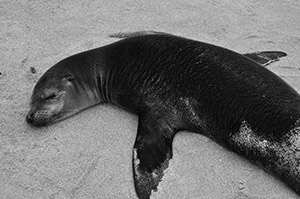In Brief
Sea lion seizures
Illness provides insight into epilepsy

In the first four months of this year, 40 sea lions turned up on Northern California shores suffering from seizures caused by a neurotoxin found in algae. That’s 13 more of the animals than last year during the same period and more than double in previous years. The sea lions had been feeding on small fish contaminated with domoic acid, a toxin that has increased along with the growth in algae blooms on the coast.
A recent study led by Stanford scientists characterized the brain damage caused by this toxin. What they found could lead to better therapies not only for the pinnipeds but also for humans.
Paul Buckmaster, PhD, DVM, a professor of comparative medicine, and his colleagues examined the brains of the affected sea mammals and found a pattern of damage in the hippocampus — the brain’s memory center — similar to that in humans with temporal lobe epilepsy, one of the most common forms of the disease. The animals had lost 50 percent of the neurons in the hippocampus, with the damage occurring on just one side of the brain.
“That was really surprising,” says Buckmaster, a veterinarian specializing in epilepsy. “That is what you find in people — 80 percent of the time the damage is just on one side.” In rodents, the animals typically used in epilepsy studies, damage appears on both sides of the brain. The ailing sea lions also showed a pattern of nerve cell reorganization in the brain matching that of humans with epilepsy.
Since 1998, the Marine Mammal Center in Sausalito, Calif., has rescued a few hundred sea lions with epilepsy every year. And while anticonvulsive drugs can help control symptoms in both species, the disease has no cure.
Buckmaster has been collaborating on the project with the marine center for the last four years and continues to study the brains of those animals that are beyond rescue.
“What we need is an interventional treatment — both in humans and sea lions,” Buckmaster says. “You’d give the treatment right after the brain injury, and that would prevent them from developing epilepsy. That’s the dream, but we are not there yet.”